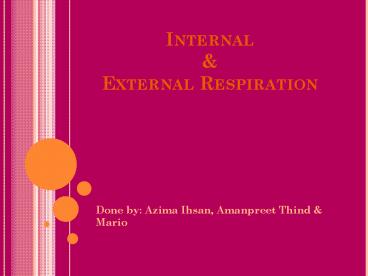Internal PowerPoint PPT Presentation
1 / 17
Title: Internal
1
InternalExternal Respiration
- Done by Azima Ihsan, Amanpreet Thind Mario
2
Four Phases of
Respiration
- Breathing
- act of inhaling and exhaling gases
- External Respiration exchange of gases between
air in the alveoli and blood in the pulmonary
capillaries - Internal Respiration exchange of gases in the
systemic capillaries and tissue fluid - Cellular Respiration
- process of oxidizing food molecules
3
Site of Internal and External Respiration
4
Transport of Oxygen By Blood
- Oxygen is transported in two forms in the
blood - 1. Physically dissolved in plasma (2 )
- Compared to carbon dioxide, oxygen is relatively
insoluble in plasma - 2. Bound to the haemoglobin molecule (Hb) (98 )
- Hb can combine rapidly and reversibly with
oxygen. - The reversibility of this reaction allows oxygen
to be released to the tissues. - Hb O2 in
lungs HbO2 - Deoxyhaemoglobin in tissue
Oxyhaemoglobin - (a.k.a reduced Hb)
5
The Oxyhaemoglobin Dissociation Curve
- a. Loading oxygen in the lungs
- Venous blood entering the pulmonary capillaries
has a PO2 of 40 mm Hg - As the blood passes through the pulmonary
capillaries, it equilibrates with the alveolar
PO2 of about 100 mmHg - b. Unloading oxygen at the tissues
- As blood passes from the systemic arteries into
the capillaries, it is exposed to lower PO2,
oxygen is released from Hb
6
Factors that enhance the unloading of the oxygen
- Factors that enhance the unloading of the oxygen
at the tissues and shift the curve to the right - H, pH
- 2) PCO2 (Bohr Shift)
- 3) temperature
pH Temperature
7
Other Factors That Affect Oxygen Transport in The
Blood
- 1) Anaemia
- The Hb saturation is not affected
- The reduced amount of haemoglobin per 100 ml
blood decreases the oxygen carrying - capacity of the blood
8
- 2) Carbon Monoxide (CO)
- The affinity of Hb for carbon monoxide is 240
times that for O2 - CO competitively blocks the combination of
oxygen with Hb - CO bound Hb is called carboxyhaemoglobin (HbCO)
- Together these characteristics of CO can lead to
severe tissue hypoxia
9
How is Co2 carried in the blood?
- 1. Physically dissolved in plasma (5)
- Carbon dioxide is much more soluble in blood
than oxygen - 2. Bound to haemoglobin and plasma proteins (5)
- Carbon dioxide combines reversibly with
hemoglobin to form carbaminohaemoglobin. - Carbon dioxide binds to amino groups on the
polypeptide chains of haemoglobin - Carbon dioxide also binds to amino groups on
the polypeptide chains of plasma proteins
10
- 3. BICARBONATE IONS (HCO3- ) (90)
- Carbon dioxide enters red blood cells in the
tissue capillaries, combines with water to form
carbonic acid (H2CO3) - This reaction is catalyzed by the enzyme
carbonic anhydrase (C.A.), which is found in the
red blood cells. - Carbonic acid then dissociates to form
bicarbonate ions (HCO3- ) and hydrogen ions (H). - CO2H20 H2CO3 HCO3-H
11
(HCO3- ) IN TISSUE AND
LUNGS
- The hydrogen ions combine with haemoglobin in
the red blood cell. - Bicarbonate ions diffuse out into the plasma
whilst chloride ions (Cl-) to diffuse in
(chloride shift).
- The reversal of the reactions which occurs at the
lungs. - Bicarbonate ions enter the red blood cells and
combine with hydrogen ions to form carbonic acid.
- This is broken down into carbon dioxide and
water. - Carbon dioxide diffuses out of the red blood
cells into the alveoli.
12
The Carbon Dioxide Dissociation Curve
- Transport of CO2 is dependent on O2 release.
- The CO2 dissociation curve is influence by the
state of oxygenation of the Hb - High PO2 tends to displace CO2 from haemoglobin
(Haldane effect) - It takes place in lungs causing release of CO2
from the blood.
13
External Respiration
- As O2 passes from the alveoli into the red blood
cells, Hb becomes saturated with O2 - Hb releases H that binds to more HCO3- to form
carbonic acid - The carbonic acid dissociates into CO2 and water
- The CO2 diffuses from the blood into the alveoli.
14
Internal Respiration
- CO2 leaves the tissue cells and enters the red
blood cell - It causes more O2 to dissociate from Hb (Bohr
shift) - Thus more CO2 combines with Hb and
- More HCO3 is produced
15
Quiz
- Where does External and Internal Respiration
takes place? - External in lungs and internal at tissues
- 2 ways by which O2 travels in blood
- As dissolved in plasma and oxyhaemoglobin.
- Does this reaction occur at the lungs
- or at the tissue?
- Hb O2 HbO2
- In lungs or pulmonary capillaries.
- 3 ways by which CO2 travels in blood
- As dissolved in plasma, carbaminohaemoglobin,
and - bicarbonate ions.
16
What are these curves called?
Oxyhaemoglobin dissociation curves.
17
Bibliography
- Mader, S Sylvia. Inquiry into Life. New York
McGraw-Hill, 1997. - Osborne, Sally. Transport of Oxygen by Blood.
Blood gas transport. 10November 2007.
www.sallyosborne.com/Med20Lecture20Transport20O
f20Blood20Gases202007. - Respiration. Internal and External
respiration. 10 November 2007.
www.coolschool.ca/lor/BI12/unit11/U11L05. - Gas transport in blood. Gas exchange. 10
November 2007. www.healthsystem.virginia.edu/Inter
net/AnesthesiologyElective/airway/gastransport.cfm
- Binding of Ligands. Haemoglobin. 12 November
2007. www.en.wikipedia.org/wiki/UserSaravask/Hemo
globin. - Haemoglobin saturation. Human Physiology. 12
November 2007. www.people.eku.edu/ritchisong/301no
tes6.

